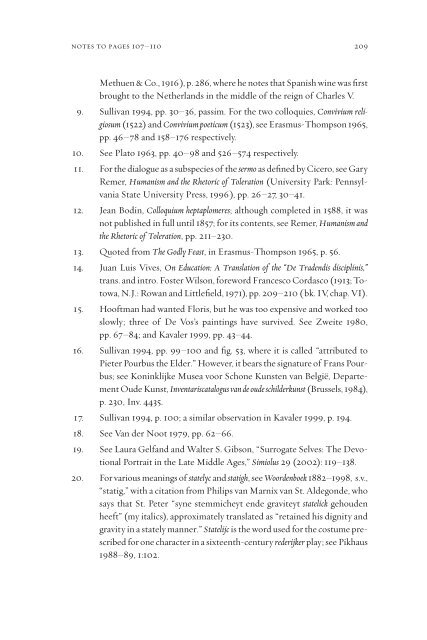Pieter Bruegel and the Art of Laughter - AAAARG.ORG
Pieter Bruegel and the Art of Laughter - AAAARG.ORG
Pieter Bruegel and the Art of Laughter - AAAARG.ORG
You also want an ePaper? Increase the reach of your titles
YUMPU automatically turns print PDFs into web optimized ePapers that Google loves.
notes to pages 107–110 209<br />
Methuen & Co., 1916 ), p. 286, where he notes that Spanish wine was first<br />
brought to <strong>the</strong> Ne<strong>the</strong>rl<strong>and</strong>s in <strong>the</strong> middle <strong>of</strong> <strong>the</strong> reign <strong>of</strong> Charles V.<br />
9. Sullivan 1994, pp. 30–36, passim. For <strong>the</strong> two colloquies, Convivium religiosum<br />
(1522) <strong>and</strong> Convivium poeticum (1523), see Erasmus-Thompson 1965,<br />
pp. 46–78 <strong>and</strong> 158–176 respectively.<br />
10. See Plato 1963, pp. 40–98 <strong>and</strong> 526–574 respectively.<br />
11. For <strong>the</strong> dialogue as a subspecies <strong>of</strong> <strong>the</strong> sermo as defined by Cicero, see Gary<br />
Remer, Humanism <strong>and</strong> <strong>the</strong> Rhetoric <strong>of</strong> Toleration (University Park: Pennsylvania<br />
State University Press, 1996 ), pp. 26–27, 30–41.<br />
12. Jean Bodin, Colloquium heptaplomeres; although completed in 1588, it was<br />
not published in full until 1857; for its contents, see Remer, Humanism <strong>and</strong><br />
<strong>the</strong> Rhetoric <strong>of</strong> Toleration, pp. 211–230.<br />
13. Quoted from The Godly Feast, in Erasmus-Thompson 1965, p. 56.<br />
14. Juan Luis Vives, On Education: A Translation <strong>of</strong> <strong>the</strong> “De Tradendis disciplinis,”<br />
trans. <strong>and</strong> intro. Foster Wilson, foreword Francesco Cordasco (1913; Totowa,<br />
N.J.: Rowan <strong>and</strong> Littlefield, 1971), pp. 209–210 ( bk. IV, chap. VI).<br />
15. Ho<strong>of</strong>tman had wanted Floris, but he was too expensive <strong>and</strong> worked too<br />
slowly; three <strong>of</strong> De Vos’s paintings have survived. See Zweite 1980,<br />
pp. 67–84; <strong>and</strong> Kavaler 1999, pp. 43–44.<br />
16. Sullivan 1994, pp. 99–100 <strong>and</strong> fig. 53, where it is called “attributed to<br />
<strong>Pieter</strong> Pourbus <strong>the</strong> Elder.” However, it bears <strong>the</strong> signature <strong>of</strong> Frans Pourbus;<br />
see Koninklijke Musea voor Schone Kunsten van België, Departement<br />
Oude Kunst, Inventariscatalogus van de oude schilderkunst (Brussels, 1984),<br />
p. 230, Inv. 4435.<br />
17. Sullivan 1994, p. 100; a similar observation in Kavaler 1999, p. 194.<br />
18. See Van der Noot 1979, pp. 62–66.<br />
19. See Laura Gelf<strong>and</strong> <strong>and</strong> Walter S. Gibson, “Surrogate Selves: The Devotional<br />
Portrait in <strong>the</strong> Late Middle Ages,” Simiolus 29 (2002): 119–138.<br />
20. For various meanings <strong>of</strong> statelyc <strong>and</strong> statigh, see Woordenboek 1882–1998, s.v.,<br />
“statig,” with a citation from Philips van Marnix van St. Aldegonde, who<br />
says that St. Peter “syne stemmicheyt ende graviteyt statelick gehouden<br />
heeft” (my italics), approximately translated as “retained his dignity <strong>and</strong><br />
gravity in a stately manner.” Statelijc is <strong>the</strong> word used for <strong>the</strong> costume prescribed<br />
for one character in a sixteenth-century rederijker play; see Pikhaus<br />
1988–89, 1:102.












